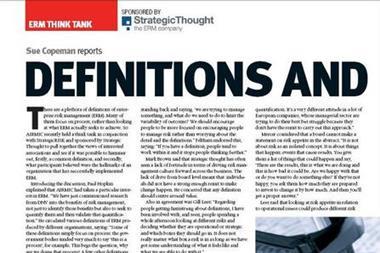Oskar Buchauer: From my point of view, reinsurance optimisation could be an area where we could really tie up and link the overall risk strategy or P&L volatility to the reinsurance process and my goal would be to establish such a link. However, I am not totally comfortable with the approach of centralising all the reinsurance functions. Coming from a local organisation within a big group, at the end of the day from a legal point of view there is a huge concentration risk for the group company that is assuming all the various reinsurance needs and then ceding it outwards. It makes good sense for the group but from a local point of view there is a counter-party risk. At the end of the day there is also a legal aspect which is driven by local regulations and by Solvency II.
Tom Wilson: I think Solvency II has made apparent the difficult legal entity structure that many international primary insurance companies currently have. At present we can have a primary company for life and another for P&C within the same country, with the same structures in each country. Under Solvency II, you won’t be able to recognise as much of the diversification across these legal entity barriers. This means that the next big cultural and organisational challenge will be balance sheet and legal entity management to capture the most diversification benefits out of Solvency II.
Giovanni Gentile: The impact on the corporate structure in Europe of the Solvency II framework is only starting to be appreciated.
Sue Copeman: Let’s move on to strategic business planning and alignment of underwriters’ compensation.
Jonathan Titman: This goes back to some points we were making earlier. If we take the issue of underwriters and how their interests are aligned with that of the company, I think there is some evidence that their compensation is based on metrics that are not based on the value that they are adding to the organisation. They are around things like combined ratio targets which may be very blunt instruments with which to measure the success or otherwise of a particular underwriter. An extreme example of that is catastrophe business and normally companies will strip out the impacts of catastrophes on underwriting results when assessing compensation. To take another example, you may have an underwriter who perhaps writes high layer casualty risks on the basis that he thinks they are profitable because there has been no loss activity and he hopes he may get lucky. But that may not be at all what was envisaged in the company’s plan and its risk appetite. The strategic plan may be to write working layer casualty business but the underwriter can manipulate the system to some degree by writing high layers. If there is no feedback mechanism to show the management that is what’s happening, then you could get a situation at the end of the year where underwriters will have very good results, very low loss ratios and they will be compensated accordingly. But the amount of risk that has been taken on by the company has been much higher than was anticipated, and the underwriter is getting rewarded for taking that risk unknown to the company. If there was a concise framework in place with enough feedback loops and integration of the strategic planning with the compensation structure, the underwriters would be compensated according to the real risk they have taken and the real value that they have added when writing those risks.
Tom Wilson: This is a question that is very much geared towards commercial lines and reinsurance. For the great bulk of personal financial services, whether it is auto, home or life insurance, etc, this isn’t an issue.
Olly Reeves: A lot of the business that Lloyd’s writes is heavily reliant on the skill and experience of underwriters and these are writing very different business. So putting in consistent and relevant measures for their compensation is inherently very difficult.
Tom Wilson: Do you do peer reviews or business reviews on a regular basis?
Olly Reeves: Yes, there are all sorts of control activities you can put in place, but purely measuring performance in that respect is just very difficult. Potentially you can put a lot of operational measures in place around the underwriting procedure but the skill and diligence of an underwriter in his class has to be more of a range. The second point is around common understanding of risk. Typically, underwriters are not from a risk management background but are used to making an educated and informed decision on a specific piece of business. They have not been developed and trained in the more operational type of things, which models they should check, etc. So culture plays a big part.
Tom Wilson: You have got to be careful what you measure as well. If you are in a cyclical business you have potentially got a problem because a lot of the underwriters don’t have transportable skills to other business lines. You have to recognise that sometimes they are going to write less business and sometimes they are going to write more because you don’t want them to and your performance measurement and metrics have to support that.
Olly Reeves: You measure what you can. I think a good measure would be how many pieces of business underwriters walk away from at the appropriate time in the cycle. But in terms of combined ratios and where they are against the business plan, none of that comes through. It is not about what business you don’t write, it is about what you have written, and then at what point losses come through.
Sue Copeman: Moving on, would you like to comment on cultural challenge, Tom?
Tom Wilson: We are going through the process of introducing new metrics and trying to change the way we fundamentally look at a business, both on the risk side and the value side. There will be businesses that will look better under these new metrics and those that look worse. Getting an organisation to (a) recognise (b) accept and (c) take action on those observations is important because you don’t have impact unless strategic and tactical decisions are taken. Unfortunately, organisations are very complex, you have vested interests all over the place, and you may have people who have been doing something in the same way for 20 years and don’t see why they should do it any differently. The challenge is understanding how to navigate on the softer issues.
Giovanni Gentile: That can only happen if there is real top management support for it. Otherwise nothing will be done.Another cultural change aspect which we’ve touched on before is that risk management is not the same as it was some years ago. Risk management and finance or capital management are increasingly blurring into one, the traditional boundaries are breaking down, and a lot of companies are culturally challenged because they used to attract different talents in these different areas and suddenly these people need to speak the same language. If you include treasury as well, it is more complicated.
Ferdia Byrne: There are several old disciplines where everyone has to learn some new skills to deal with risk management and it goes across all of them. We all have to upgrade our skills to deal with cultural change. The actuaries and risk managers need to understand more of the accountants’ perspective, processes, consolidations and so on, and equally they need to understand the numbers they are getting from risk managers, for example when you work out capital attribution.
Tom Wilson: My initial comment was more about how you get cultural change so that risk can have impact within an organisation. That leaves aside the question of what type of cultural change you want from your risk function itself. From a life insurance perspective there are at least two things that I would like. One is getting the technical people away from an analysis and a “memo to file” approach into taking a position and a view and being more involved in the risk underwriting process as an independent check and balance. That is the risk management cultural change that I am trying to get across. The second thing I am trying to do is to get my technical resources to start thinking like financial engineers. We sell highly complicated savings and asset accumulation products, for example involving click options, high water marks, averaging options, and I’d like them to build their skills and understand these financial products in addition to the traditional actuarial areas of mortality, morbidity, longevity, etc.
Oskar Buchauer: We are currently integrating two companies, and it has become very clear how risk taking approaches in the sense of ERM affect all the various areas of an organisation. When you try to bring two cultures together, the questions of how to deal with risk and treat risk occur in pricing, underwriting and actuarial areas, in reserving processes, all different kinds of areas. It is an interesting challenge not just to integrate two cultures but to bring a new risk culture on top of that.
Sue Copeman: Perhaps we could talk about systems now?
Tom Wilson: As a large primary insurance group that has historically been put together through acquisition and run on a more decentralised manner, trying to get a more centralised and stronger finance and risk column is often inhibited by information flows. A lot of the techniques that we use to aggregate risk are basically very high level. There may be a hundred numbers floating around like interest rate economic capital and equity economic capital because the systems infrastructure is very diverse. There are 35 different countries, each with an average of two and a half different operating entities with their own systems. Even inside one of those companies, there are different systems. This means that getting new information consistently and efficiently can be a little bit of a nightmare – and expensive.















